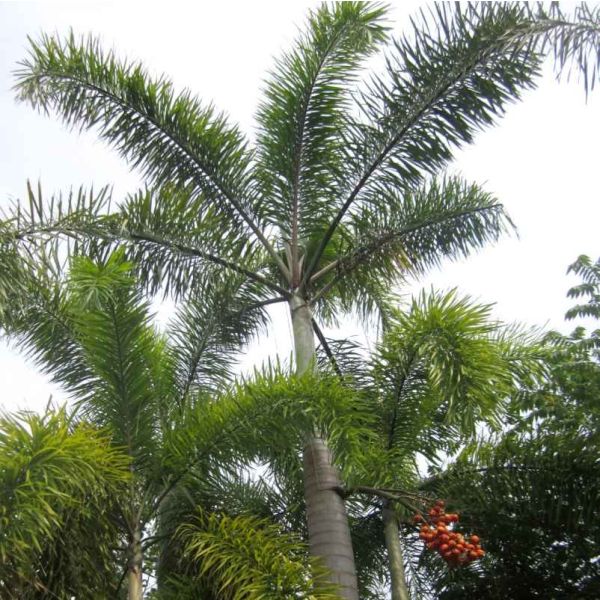Wodyetia Bifurcata Seeds (Foxtail Palm Seeds)
Wodyetia Bifurcata Seeds (Foxtail Palm Seeds)
The foxtail palm becomes even showier when its brilliant red fruit is on display. One of the world's most beautiful palms, Foxtail Palm is always in high demand.

Delivery
All orders shipped with UPS Express.
Always free shipping for orders over US $250.
All orders are shipped with a UPS tracking number.
Returns
Items returned within 14 days of their original shipment date in same as new condition will be eligible for a full refund or store credit.
Refunds will be charged back to the original form of payment used for purchase.
Customer is responsible for shipping charges when making returns and shipping/handling fees of original purchase is non-refundable.
All sale items are final purchases.
Help
Give us a shout if you have any other questions and/or concerns.
Email: contact@domain.com
Phone: +1 (23) 456 789
Availability: Out of stock
SKU
Wodyetia Bifurcata
Wodyetia bifurcata is also called The Foxtail Palm and comes from Queensland, Australia. This solitary palm is very durable and adaptable to many environments. The foxtail palm becomes even showier when its brilliant red fruit is on display. One of the world's most beautiful palms, Foxtail Palm is always in high demand. The Foxtail can grow as much as three feet per year, and can sometimes reach 30 feet in height.
The foxtail palm has one of the most spectacular foliage displays of all palms. Fine, narrow leaflets radiate out from the leaf stalks, giving a plumose, or foxtail appearance. The pale green arching fronds have leaflets that radiate out at all angles from the leaf stem, thus appearing like a bottlebrush or the tail of a fox. A mature foxtail palm has a creamy green and very smooth canopy of 8-10 leaves, each with the characteristic foxtail or bottlebrush appearance, and a crown of foliage 15-20 ft (4.6-6.1 m) across.
Foxtail palm is thorn less and has a smooth, slender, closely ringed bottle shaped to columnar trunk that grows up to 30 ft (9.1 m) tall. The trunk is self-cleaning, gray in color, tightly ringed and slightly swollen at the base.
The Foxtail Palm's green inflorescence is borne on a thick stem emerging from the crown shaft. The oval shaped fruits, which emerge from the creamy green bloom, turn orange red at maturity forming an attractive display. Fruits are large (1.25" x 2.25") and produce the palm seed. The foxtail palm bears white blossoms of both sexes at the base of its crown, and a single palm is capable of producing fertile seeds. Foxtail palm produces colorful clusters of red to orange-red fruit, each containing just one seed.
Hardiness zones: 9*-11, (-5øC/25øF, 4øC/40øF) in winter. (note: zone 9* will need winter protection outside). Foxtail palms are exceptionally hardy and easy to grow. They tolerate a wide variety of well drained soils, including alkaline limestone soils and rocky sands. Fertilizer for foxtail palm should have ample amounts of micronutrients and slow release potassium. With a very deep root system the Foxtail can withstand a great variance in water and temperature. This tree is moderately salt tolerant. It loves sun, even at an early age. This palm can tolerate light frost and does well in temperate to tropical climates. Prolonged hot dry winds can cause damage to the fronds. The root system allows planting near
walkways or structures.
| Common name | Foxtail Palm |
|---|---|
| Species | Wodyetia bifurcata |
| Germination | Foxtail palm is propagated by seeds. Scarify the seeds first. Then place the seeds in a plastic bag with a moist peat moss (or even better coconut fiber), then place the bag in a warm place. Don't over water otherwise fungus may occur. This tropical palm needs a temperature of about 86-95øF. If you raise the temperature, you may "cook" the seeds, but lower temperature will make germination slow down if ever at all. You may use a heating pad to warm up the bag with seeds. Some seeds germinate 2-3 months after sowing, and others will take up to 12 months to sprout. Try not to disturb the root because it is still very fragile. Plant the seedling in a deep pot, so that the seed is a little bit under soil level, but the upper sprout stands upright. Of course the soil should be very well-drained. Place the pot where the seedling gets enough sunlight but not direct full sun. Water often, without letting the soil over dry. At first the seedlings grow fairly slow, but with time the growth will speed up. |
| Scarification / Stratification | Seed coats may be so hard that they are impermeable to water. They need to be scratched or broken using a knife or sandpaper, in order to germinate. Chip the seeds with a sharp knife or make a few swipes with a sharp edged file or use sandpaper to allow moisture being more readily absorbed. |
| Price View | Price Range |

